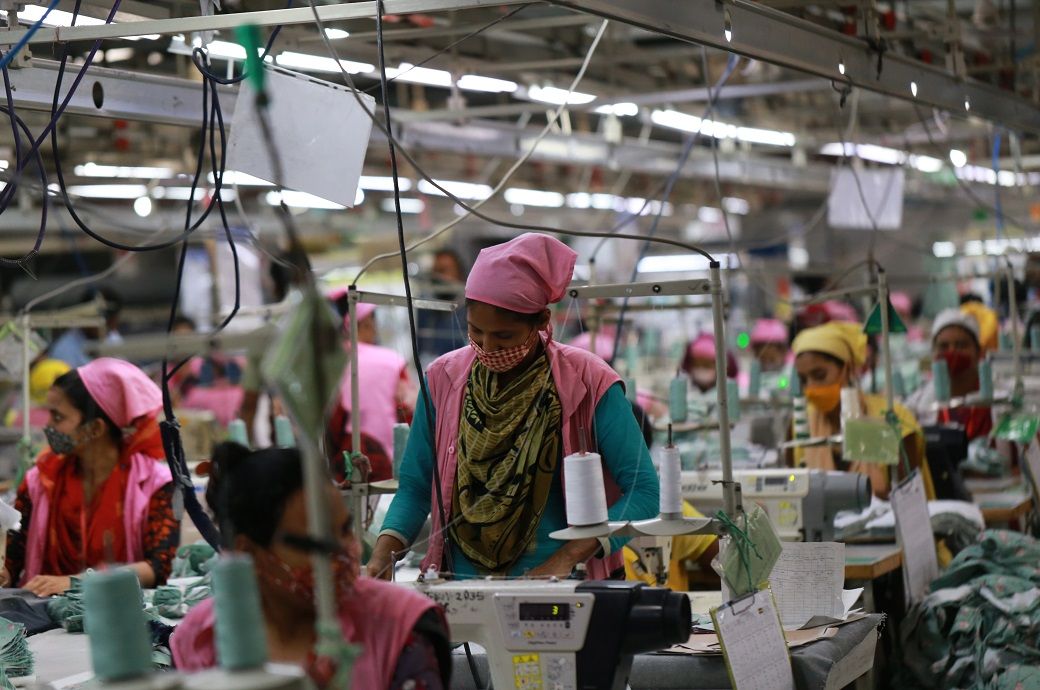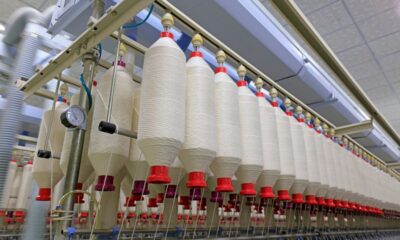Fashion
Alberta Ferretti: Haute hosting for today

Published
September 24, 2025
The special art of hosting a soirée, arguably a dying social skill, was the key to a swish and stylish collection by Lorenzo Serafini for the house of Alberta Ferretti this season.
Using whisper-light fabrics – chiffon, floaty silk and crochet – Serafini offered up a fresh vision of evening elegance. Created in a great palette of ecru, foam green, Aegean blue and coral pink, the summer shades were in marked contrast to a Milan Tuesday of heavy clouds and intermittent showers.
Staged with grace inside a neo-classical Milanese palazzo with marble floors and frescoes of peacocks and pheasants, an ideal location for a refined supper. Throughout there was a sense of sensual confidence, imparted by some great combinations. Flared chiffon pants with meter-long scarf tops; flowing tents dresses that billowed out when walking; halter necks held with metallic silver collars. Or splendid deep George gowns, and some super color-blocked Moorish dresses.

Many dresses and skirts trimmed with fabric beads and baubles, on a cast many of whom wore posh hippie fringed moccasins.
“I was imagining the most perfectly dressed host for today. Spending comfortable quality time in an intimate scenario. A private world, not over exposed on social media,” explained a smiling Serafini. Standing before a mood board that included images of Sofia Coppola, Stella Tennant and Tina Chow.
“Tina was one of the highest hostess. Nothing nostalgic. I wanted a homage to these free spirits. I wish we had more of them nowadays,” he stressed.

This week Alberta Ferretti also opened of the new flagship store in Milan, in Via Spiga 26, in the heart of the Quadrilatero Della Moda. Spread over two levels, the new boutique is developed around architectural elements that convey the atmosphere of a wardrobe-living room, where the use of a resin, specially made by a Milanese artisan for the walls and floor, creates an “infinite” effect.
A precious table in Canaletto walnut and brass with curved lines evokes the world of jewelry. Walnut bookcases are designed to showcase bags and accessories, and day-bed seats featuring an ivory bouclé fabric upholstery, define a relaxing and immersive journey into the brand.
Copyright © 2025 FashionNetwork.com All rights reserved.
Fashion
Bangladesh garment makers eye $5 bn more in exports post policy tweak

Under this arrangement, the buyer supplies raw materials like fabrics and accessories. Manufacturers receive only the cutting and making charges.
Bangladesh apparel manufacturers expect an additional $5 billion from high-end garment exports in the first year after the government scraps the 50-per cent ceiling on free-of-charge (FoC) imports, trade body BGMEA said.
Under this arrangement, the buyer supplies raw materials.
The additional earnings could cross $10 billion in the second year once the FoC quota is fully abolished, BGMEA noted.
The additional earnings could cross $10 billion in the second year once the FoC quota is fully abolished, Chowdhury said.
The country’s Ministry of Commerce has decided to amend the Import Policy Order within the next two weeks, allowing garment exporters to source all raw materials from overseas buyers, process them and ship the finished products back, the Chief Adviser’s Office said.
Exporters now are permitted to import only half of the required raw materials under the FoC arrangement.
A few years ago, FoC imports were capped at 33 per cent of total raw materials. This was raised to 50 per cent later.
Bangladesh’s apparel exporters use FoC for less than 5 per cent of total shipments now due to restrictive conditions and reported complications at the Chattogram customs department.
As FoC is straightforward, less risky and faster, garment exporters feel without any quota on FoC import, global brands will place more orders with Bangladesh.
Manufacturers say orders for high-end man-made fibre and polyester garments are shifting from China to Bangladesh as the United States has imposed higher tariffs on Chinese goods.
Many Bangladeshi factories, however, cannot take full advantage of this as these are barred from importing more than half of raw materials under the current FoC regulations.
Chowdhury said FoC reduces risk as buyers cover raw material costs and cannot abruptly cancel orders, according to domestic media outlets.
However, Showkat Aziz Russell, president of the Bangladesh Textile Mills Association (BTMA), said the government should consult all stakeholders before taking any decision. He believes higher import of raw materials could harm the domestic textile industry by reducing demand for local yarn, fabrics and accessories, and lowering local value addition.
Fibre2Fashion News Desk (DS)
Fashion
EU Commission grants over $414 mn for 132 clean transition projects

The allocated amount represents more than half of the €536 million total investment needs for these projects—the remainder coming from national, regional and local governments, public-private partnerships, businesses and civil society organisations.
The European Commission has granted over €358 million (~$414.2 million) to 132 new projects across Europe under the LIFE Programme for environment and climate action.
It will mobilise €133 million (the EU will provide €76 million) to contribute to circular economy and improving quality of life, with 31 projects backing the transition to a clean, circular, energy-efficient and climate-resilient economy.
LIFE projects play a significant role in the Eurioean Union’s (EU) transition to a clean, circular and resilient economy, helping safeguard and restore the EU’s biodiversity, supporting industrial competitiveness and contributing to the EU’s long-term goal of becoming climate-neutral by 2050.
This investment will have a lasting impact on the region’s environment, economy, industry and the well-being of all Europeans. The projects will cover all areas of the LIFE programme.
It will mobilise €133 million (of which the EU will provide €76 million) to contribute to circular economy and improving quality of life, with 31 projects supporting the transition towards a clean, circular, energy-efficient, and climate-resilient economy.
It will mobilise €96 million (of which the EU will provide €58 million) to 19 projects to strengthen climate resilience and mitigation efforts.
It will also mobilise €82 million (of which the EU will provide €77 million) to 48 projects aimed at accelerating the clean energy transition, an official release said.
Among the 31 projects selected to promote a more circular economy and quality of life, the €3.6 million LIFE Woodmer project in Sweden will produce biopolymers from waste wood to reduce hazardous chemicals and plastics in packaging and textiles.
The €1.9 million project InBioSoil in Spain uses fungi to clean up soil contaminated with persistent organic pollutants.
To ensure a clean energy transition, the 48 new projects announced today range from citizen-led local energy cooperatives to retrofitting old buildings and installing affordable heat pumps. They include the €1.2 million LIFE SUNACADEMY project, a new renewable energy training academy in France, with a focus on residential and large solar installations.
The €1.8-million NESOIplus project will provide for clean energy solutions and capacity building targeted to remote island communities in the Azores, Canaries and Martinique. And with a budget of €1.6 million, the BAIL-RENOV project will give an increased focus on landlord’s needs all along the energy renovation process in rental properties in France.
Over its 33 years of existence, the LIFE Programme has co-financed more than 6,500 environmental and climate action projects across the EU and associated countries.
The present LIFE programme started in 2021 and runs until 2027, with a budget of €5.43 billion. The grants financed under the LIFE Programme are managed by CINEA, the European Climate Infrastructure and Environment Executive Agency.
Fibre2Fashion News Desk (DS)
Fashion
Fed to cut rates in Dec, forecasts GSR; US job market weakness genuine

Seeing ‘genuine’ signs of weakness in the US job market, it does not expect the picture to change enough by the December meeting for the Federal Open Market Committee (FOMC) to stop cutting.
Goldman Sachs Research recently forecast that the US Federal Reserve will cut interest rates again in December.
Seeing ‘genuine’ signs of weakness in the US job market, it does not expect the picture to change enough by the December meeting for the Federal Open Market Committee to stop cutting.
It also expects two 25-basis-point cuts in March and June next year to a terminal rate of 3-3.25 per cent.
Though Fed chair Jerome Powell was more hawkish than expected during the central bank’s recent press conference, Goldman Sachs Research still expects policymakers to lower their target rate again this year.
It also expects two 25-basis-point cuts in March and June next year to a terminal rate of 3-3.25 per cent, it said in an insights article on its website.
The FOMC cut its target rate in October for the second time this year, lowering the fed funds rate by 25 basis points to 3.75-4 per cent. The Fed also said it would stop running off its $6.6-trillion balance sheet at the start of December. The principal payments of mortgage backed securities will only be reinvested into Treasury bills.
While most official economic data releases have been suspended by the government shutdown, Powell noted that the available official and alternative indicators suggest that inflation (net of tariff effects) is now close to the 2-per cent target and that the labour market has continued to cool gradually.
The FOMC’s summary of economic projections for September implied that most participants saw a December cut as the baseline, according to Goldman Sachs Research. The Fed’s past packages of risk management cuts (proactive rate cuts to guard against potential risks to the economy) also suggest that a third and final cut is the default.
Labor market data are “unlikely to send a convincingly reassuring message” by the time of the FOMC meeting in December, David Mericle, chief US economist, wrote in the team’s report.
Deferred resignations of government employees instigated by the Department of Government Efficiency are likely to generate a negative payrolls report in October and “weigh a bit on November,” Mericle added.
Fibre2Fashion News Desk (DS)
-

 Business1 week ago
Business1 week agoAndy Jassy Reveals Real Reason Behind Amazon 14,000 Job Cuts — And It’s Not AI
-

 Sports1 week ago
Sports1 week agoTudor’s Juve exit means McKennie must prove himself all over again
-

 Politics1 week ago
Politics1 week agoPolitical violence kills almost 300 since Hasina’s fall: rights group
-

 Politics1 week ago
Politics1 week agoIran vows to rebuild nuclear sites ‘stronger than before’
-

 Tech1 week ago
Tech1 week agoStep Away From Screens With the Best Family Board Games
-

 Sports1 week ago
Sports1 week agoPakistani runners make their mark at Istanbul Marathon
-

 Entertainment1 week ago
Entertainment1 week agoPresident Zardari to attend Second World Summit for Social Development in Doha
-

 Tech1 week ago
Tech1 week agoLive TV Isn’t Dead. These Are the Best Live TV Streaming Services

















